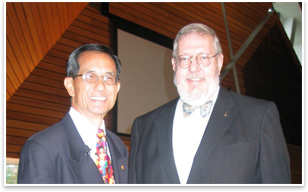Minnesotans Kick Off Livable Communities Celebration
by Tracy Ostroff
Summary: AIA Minnesota kicked off its AIA150 year of celebration September 21 with its program “Livable Communities—A Town Hall Forum” for mayors, civic leaders, architects, and design professionals. To anchor the program, the Minnesotans turned to Ben Lee, FAIA, former managing director of Honolulu (the city voted as the most livable by the International Awards for Livable Communities) and leaders from Minnesota communities to educate both practitioners and the public on ways the groups can work together to establish a definition of livable communities and be leaders in the effort to create them.
 Lee framed the discussion by highlighting Honolulu’s path toward livability. At the surface, the comparisons between Minnesota and Hawaii may not be obvious, but AIA Minnesota past president and conference organizer Howard Goltz, AIA, says “lessons from city to city transfer very easily. The politics of creating livable cities and the partnerships required to make that happen are similar everywhere.” Lee’s leadership and experience, Goltz notes, underscore the important role architects have to play in that dialogue. “Architects can be catalysts for that development,” he says. Lee framed the discussion by highlighting Honolulu’s path toward livability. At the surface, the comparisons between Minnesota and Hawaii may not be obvious, but AIA Minnesota past president and conference organizer Howard Goltz, AIA, says “lessons from city to city transfer very easily. The politics of creating livable cities and the partnerships required to make that happen are similar everywhere.” Lee’s leadership and experience, Goltz notes, underscore the important role architects have to play in that dialogue. “Architects can be catalysts for that development,” he says.
That message was at the root of the forum, which evolved over the past few years as a way to spur architects to become more involved as leaders in their communities and to educate the public about how to be engaged in a successful process with architects. Goltz says he hopes programs like these will encourage more architects to step up to leadership positions in local and state government.
Success stories
The seminar gathered perspectives from a cross-section of urban, suburban, and rural areas and from AIA Minnesota’s Design Team. Livability 101, which outlines the AIA’s 10 Principles for Livable Communities, guided the discussions of the local mayors and city officials, who offered examples of how their initiatives in their city tied to the AIA document. AIA Minnesota Communications Director Jennifer Gilhoi reports that the group agreed that:
- Leadership is critical in keeping the focus during the lengthy process to create positive change for a community
- All of the stakeholders should be involved at each step of the way to prevent resistance to change
- Key decision makers should be involved early and plan for funding
- Small and ongoing positive changes can make significant changes long-term in a community.
Setting the stage
The program, which attracted architects, planners, city officials, and the public, is the first installment of a year-long campaign focusing on livable communities. “It’s a topic we have all awakened to in the last decade,” Goltz says, with the term itself becoming more commonplace among mayors, city planners, and even the public. Each of the state’s chapters will follow up with their own programs. Goltz reports:
- Minneapolis Mayor R.T. Rybak and AIA Minneapolis launched the Mayor’s Great City Design Teams, comprising architects, landscape architects, urban designers, and developers who will work with residents and community groups to develop design visions for their neighborhoods
- Architects in St. Paul are working on an extensive analysis of University Avenue, a future rapid transit route; an architect will adopt each block of the long stretch that connects the Twin Cities and will work with all the offices, businesses, and industries that occupy the area; the effort will be coordinated with city officials
- In Duluth, the Northern Minnesota chapter will hold a public forum investigating water as a core element in the development of the city and region
- AIA Minnesota is sponsoring the convention keynote speaker, Timothy Beatley, the Teresa Heinz Professor of Sustainable Communities.
|


 Lee framed the discussion by highlighting Honolulu’s path toward livability. At the surface, the comparisons between Minnesota and Hawaii may not be obvious, but AIA Minnesota past president and conference organizer Howard Goltz, AIA, says “lessons from city to city transfer very easily. The politics of creating livable cities and the partnerships required to make that happen are similar everywhere.” Lee’s leadership and experience, Goltz notes, underscore the important role architects have to play in that dialogue. “Architects can be catalysts for that development,” he says.
Lee framed the discussion by highlighting Honolulu’s path toward livability. At the surface, the comparisons between Minnesota and Hawaii may not be obvious, but AIA Minnesota past president and conference organizer Howard Goltz, AIA, says “lessons from city to city transfer very easily. The politics of creating livable cities and the partnerships required to make that happen are similar everywhere.” Lee’s leadership and experience, Goltz notes, underscore the important role architects have to play in that dialogue. “Architects can be catalysts for that development,” he says.